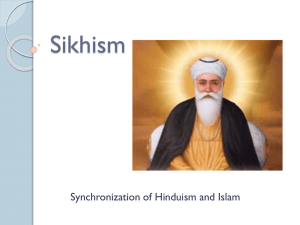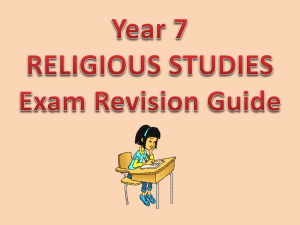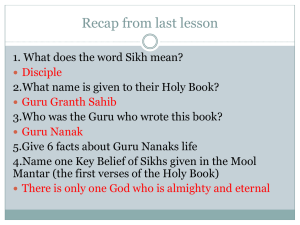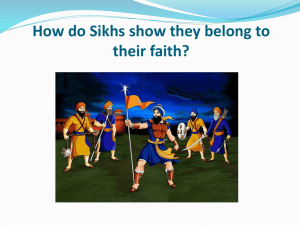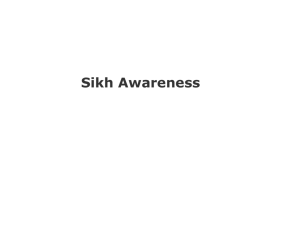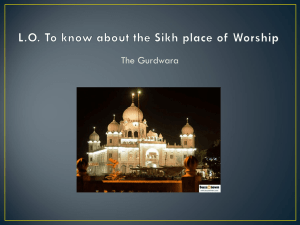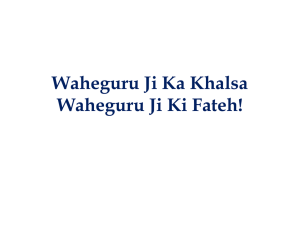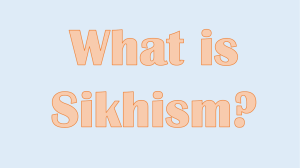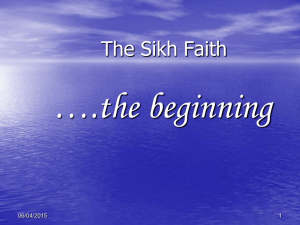Guru Gobind Singh and the Formation of the Khalsa
advertisement
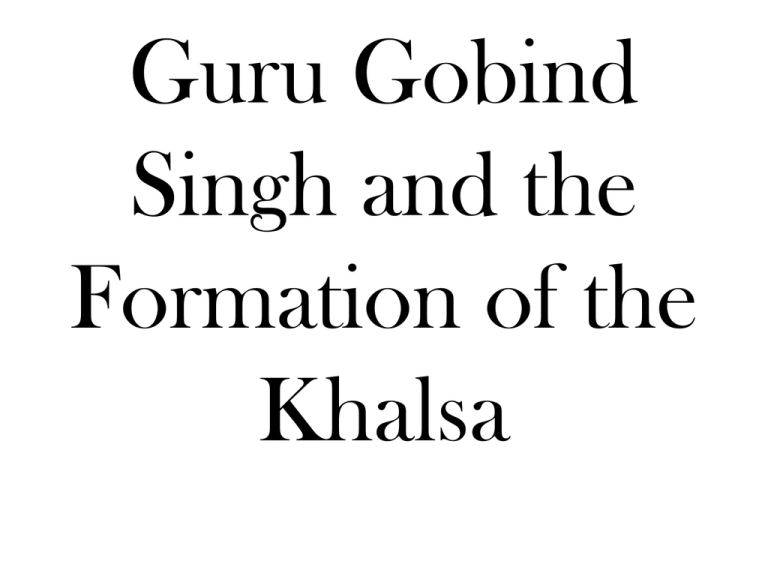
Guru Gobind Singh and the Formation of the Khalsa • • • • • Final human Guru, guruship lasted 1675 – 1708 CE. M9’s son Guru Gobind Singh is remembered for two main contributions: (a) The formation of the khalsa (brotherhood of Sikhs which gave Sikhs an outward identity), (b) The installation of the Adi Granth as the eternal Guru of the Sikhs. The masand system abolished According to tradition accounts of the khalsa ceremony, Guru Gobind Singh summoned the Sikhs to an assembly on Vaisakhi at Anandpur, in 1699 CE, and exhorted them to strength and loyalty. The events of this day have been recorded by a Mughal news writer. Gobind asked the people for a volunteer who would be beheaded. Naturally, the congregation was startled, wondering why the guru was asking for heads. Eventually a Sikh came forward and disappeared into Gobind’s tent. Gobind emerged alone with a blood-stained sword. This was repeated four times with four more volunteers. Each time the guru emerged from the tent, the congregation had presumed he’d killed the volunteers. However, finally, Guru Gobind Singh re-emerged from the tent with all five men who were now dressed identically. These five men were initiated into the brotherhood of Sikhism, now known as the khalsa, by an initiation rite known as khande-di-pahul, that is, initiation via the sword, rather than charanamrit which had been used up until now to initiate members into the Sikh faith. • • All male members of the khalsa took the name Singh, which means ‘lion’; all female members took the name of Kaur, meaning ‘princess’. Compulsory for members of the khalsa to wear, at all times, its external symbols, known as the 5K’s: Kesh - this is the uncut hair and beard of the Sikh. Kangha - this is the comb which is used to keep the hair tidy and also symbolizes spirituality. Kara - the steel bracelet which is usually worn on the right wrist, symbolizing the eternal nature of God. It also represents the Sikh’s unity with God and with the khalsa. Kaccha - these are shorts which distinguished Sikhs from other Indians at the time who wore long, loose garments known as dhotis, the kaccha also allowed freedom when fighting. Kirpan - in the past the kirpan was a proper, full-sized sword. Nowadays, it is usually worn in a smaller form of a few inches long. It symbolizes dignity, self respect and readiness to fight to protect the weak and oppressed and uphold religious liberty. Why did Guru Gobind Singh establish the Khalsa? • Led to outward distinction of Sikhs • Was it the public beheading of his father? • Nobody except for 2 low-caste Sikhs came in disguise to claim his body – bravery? • Emphasis on martyrdom? • All united – no more caste names – no caste prejudice? • Caste and gender equality (sugar crystals) • The term “mazhabi” • Struggles against Mughals involved many sacrifices – his 4 sons The Adi Granth as Eternal Guru • In 1708CE M10 suffered knife wound – night before he died, 5 coins and coconut in front of Adi Granth – 2008 celebrations • 1 spirit now in Guru Granth Sahib – eternal guruship • Too much corruption? • False Gurus setting themselves up? • Miri-piri- Guru Panth (sangat) MIRI Guru Granth (scripture) PIRI Discussion questions 1. Why do you think it was important for Guru Nanak to choose a successor? 2. By appointing a successor, did Guru Nanak intend on setting up a new religion? 3. Do you think it was necessary for Sikhism to adopt a militant nature, Why? 4. Did this disobey the teachings of Guru Nanak? 5. What factors do you think led to the establishment of the Khalsa? 6. Do you think the ideals of the Khalsa were contradictory to Guru Nanak’s message that “there is no Hindu, there is no Muslim?” 7. Assess the importance of institutionalization.
